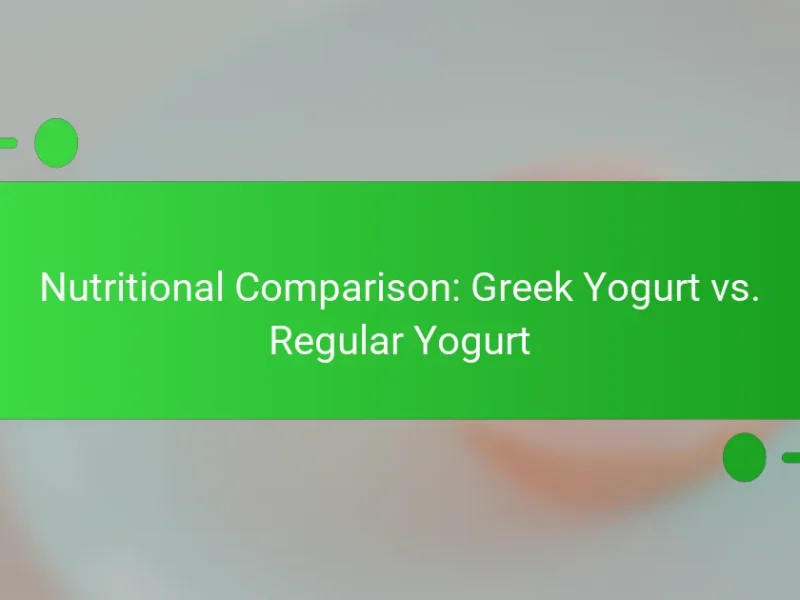Greek yogurt is a strained yogurt known for its thicker texture and higher protein content compared to regular yogurt. It typically contains about 10 grams of protein per 100 grams, with high-protein varieties offering 15-20 grams per serving, making it beneficial for muscle repair, weight management, and metabolic health. This article outlines how to choose the best Greek yogurt by focusing on protein content, ingredient quality, and fat levels. It emphasizes the importance of selecting yogurts labeled as “high-protein,” checking nutrition labels for added sugars, and considering the presence of live active cultures for gut health. Popular brands and their characteristics are also discussed to assist consumers in making informed choices.

What is Greek Yogurt and Why is Protein Content Important?
Greek yogurt is a strained yogurt that is thicker and creamier than regular yogurt. It is made by removing most of the whey, resulting in higher protein concentration. Greek yogurt typically contains about 10 grams of protein per 100 grams, compared to only 4 grams in regular yogurt. This high protein content is important for muscle repair and growth. Protein also aids in satiety, helping to control hunger and manage weight. Additionally, it supports metabolic health and can enhance the immune system. The presence of probiotics in Greek yogurt further contributes to gut health, making it a nutritious choice.
How is Greek Yogurt Different from Regular Yogurt?
Greek yogurt is different from regular yogurt primarily due to its straining process. Greek yogurt is strained multiple times to remove whey, resulting in a thicker texture. This process also concentrates the protein content, making Greek yogurt higher in protein compared to regular yogurt. Regular yogurt retains more whey, resulting in a creamier consistency but lower protein levels. For instance, a typical serving of Greek yogurt can contain around 15-20 grams of protein, while regular yogurt usually has about 8-10 grams. The nutritional differences also include lower sugar content in Greek yogurt. These distinctions make Greek yogurt a preferred choice for those seeking higher protein intake.
What processing methods contribute to Greek Yogurt’s protein content?
Straining is the primary processing method that contributes to Greek yogurt’s protein content. This method involves removing whey, which is the liquid part of yogurt. The removal of whey concentrates the protein content in the remaining yogurt. Typically, Greek yogurt contains about twice the protein of regular yogurt due to this process. Additionally, the fermentation process used in making yogurt also enhances protein levels. Specific bacteria cultures, like Lactobacillus bulgaricus and Streptococcus thermophilus, are employed during fermentation. These bacteria help break down proteins into more digestible forms. Therefore, both straining and fermentation are crucial for increasing the protein content in Greek yogurt.
How does the straining process affect nutritional value?
The straining process significantly affects the nutritional value of Greek yogurt. It removes whey, which is a liquid that contains some nutrients. This leads to a higher concentration of protein in the final product. For example, traditional yogurt contains about 10 grams of protein per serving. In contrast, strained Greek yogurt can contain up to 20 grams of protein per serving. Additionally, straining reduces sugar content, as some lactose is lost with the whey. The process also enhances the thickness and creaminess of the yogurt, making it more appealing for consumption. Overall, straining increases protein density while lowering sugar levels, making it a healthier choice for those seeking higher protein intake.
What are the Health Benefits of High-Protein Greek Yogurt?
High-protein Greek yogurt offers numerous health benefits. It is rich in protein, which supports muscle growth and repair. This yogurt typically contains around 15-20 grams of protein per serving. High protein intake can enhance satiety, aiding in weight management. Greek yogurt is also a good source of probiotics, promoting gut health. It provides essential nutrients like calcium and potassium, supporting bone health. The low sugar content in many high-protein varieties helps maintain stable blood sugar levels. Studies indicate that regular consumption can improve metabolic health and support overall wellness.
How does protein content influence muscle recovery?
Protein content significantly influences muscle recovery by promoting muscle repair and growth. Adequate protein intake helps rebuild muscle fibers damaged during exercise. It provides essential amino acids necessary for muscle synthesis. Studies show that consuming protein post-exercise enhances recovery rates. For instance, a study published in the Journal of Sports Science found that athletes who consumed protein after workouts experienced improved muscle repair. The recommended protein intake for muscle recovery is around 20-25 grams within 30 minutes post-exercise. Higher protein content in foods like Greek yogurt can therefore accelerate muscle recovery.
What role does protein play in weight management?
Protein plays a crucial role in weight management. It increases satiety, helping individuals feel full longer. This can reduce overall calorie intake. Additionally, protein has a higher thermic effect compared to fats and carbohydrates. This means more calories are burned during digestion. Studies show that diets rich in protein can lead to greater weight loss. For instance, a study published in the American Journal of Clinical Nutrition found that higher protein intake significantly reduced body weight and fat mass. Therefore, incorporating adequate protein can be beneficial for effective weight management.

How to Identify High-Protein Greek Yogurt?
High-protein Greek yogurt typically contains at least 15-20 grams of protein per serving. Check the nutrition label for protein content. Look for brands that specifically market their yogurt as “high-protein.” Ingredients like milk and live cultures indicate quality. Avoid yogurts with added sugars, as they may dilute protein content. Some brands use protein fortification methods, which can increase protein levels. Popular high-protein Greek yogurt brands include Fage, Chobani, and Oikos.
What Nutritional Labels Should You Look For?
Look for nutritional labels that highlight protein content, fat content, and added sugars. Greek yogurt should have a high protein content, ideally 10 grams or more per serving. Check the fat content to choose between full-fat, low-fat, or non-fat varieties. Aim for options with minimal added sugars, ideally less than 5 grams per serving. Additionally, consider the presence of probiotics, which are beneficial for gut health. Labels should also indicate whether the yogurt is made from whole milk or skim milk, affecting its overall nutritional profile. These labels provide essential information to make an informed choice about Greek yogurt.
How do serving sizes impact protein content comparisons?
Serving sizes significantly influence protein content comparisons. Different brands of Greek yogurt may offer varying protein amounts per serving. For instance, one brand may provide 15 grams of protein in a 150-gram serving, while another offers 20 grams in the same serving size. This variance can lead to misleading comparisons if serving sizes are not standardized. A smaller serving size might show a lower protein content, even if the product is nutrient-dense. Therefore, evaluating protein content requires careful attention to the serving size indicated on the packaging. Accurate comparisons hinge on equal serving sizes to reflect true protein content effectively.
What are the recommended daily protein intake levels?
The recommended daily protein intake levels are 46 grams for women and 56 grams for men. These values are based on dietary guidelines from health organizations. They suggest that protein should make up 10-35% of total daily caloric intake. This recommendation is designed to support overall health, muscle maintenance, and bodily functions. Specific needs may vary based on factors such as age, activity level, and health goals. For instance, athletes may require more protein to support muscle recovery and growth. The Recommended Dietary Allowance (RDA) serves as a guideline for adequate protein intake.
What Ingredients Influence Protein Levels in Greek Yogurt?
The main ingredients that influence protein levels in Greek yogurt are milk and added protein sources. Greek yogurt is traditionally made from cow’s milk, which contains about 8 grams of protein per cup. The straining process used in making Greek yogurt concentrates this protein content, resulting in higher levels compared to regular yogurt. Additionally, some brands may add protein supplements like whey or casein to further enhance protein levels. This can increase the protein content to as much as 20 grams per serving. The specific type of milk used, whether whole, low-fat, or skim, can also affect the final protein concentration.
How do additives and thickeners affect protein content?
Additives and thickeners can alter the perceived protein content of Greek yogurt. These substances may increase the viscosity and texture without adding actual protein. Common thickeners like pectin and gelatin enhance mouthfeel but do not contribute to protein levels. Some additives, such as whey protein concentrate, can genuinely boost protein content. However, others may mislead consumers about the yogurt’s nutritional value. For example, a thickened yogurt may appear richer in protein due to its consistency, even if the actual protein content remains unchanged. Therefore, it is crucial to read labels carefully to understand the true protein content.
What types of milk are used in Greek Yogurt production?
Cow’s milk and goat’s milk are primarily used in Greek yogurt production. Cow’s milk is the most common choice due to its availability and higher protein content. Goat’s milk is also utilized for its unique flavor and digestibility. Both types of milk undergo a straining process to achieve the thick consistency characteristic of Greek yogurt. This process concentrates the protein content, making Greek yogurt a popular option for those seeking higher protein intake. The protein content in Greek yogurt made from cow’s milk can reach up to 10 grams per serving, while goat’s milk yogurt may vary slightly.

How to Choose the Best Greek Yogurt for Your Needs?
To choose the best Greek yogurt for your needs, focus on the protein content and ingredients. Look for yogurt labeled as “high-protein” to ensure it meets your dietary requirements. Check the nutrition label for at least 15-20 grams of protein per serving. Consider the fat content based on your health goals; options range from non-fat to full-fat. Review the ingredient list for live active cultures, which enhance gut health. Choose brands that use minimal additives and sweeteners for a healthier option. Lastly, consider your taste preferences, as flavors can vary significantly among brands.
What Factors Should You Consider When Selecting Greek Yogurt?
When selecting Greek yogurt, consider the protein content, fat content, and added sugars. Greek yogurt typically contains more protein than regular yogurt, so check the label for grams per serving. Aim for options with at least 15 grams of protein per serving for optimal benefits.
Next, evaluate the fat content. Greek yogurt is available in full-fat, low-fat, and non-fat varieties. Choose based on your dietary preferences and goals. Additionally, watch for added sugars. Some flavored yogurts can contain significant sugars, undermining health benefits.
Lastly, check for live cultures. Probiotics contribute to gut health. Look for labels that mention “live and active cultures” for added digestive benefits. These factors collectively ensure you select a Greek yogurt that aligns with your health goals.
How do brand reputation and quality impact your choice?
Brand reputation and quality significantly influence consumer choices in Greek yogurt. A strong brand reputation often indicates reliability and trustworthiness. Consumers tend to prefer brands with positive reviews and established credibility. Quality is a crucial factor; high-quality Greek yogurt typically contains more protein and fewer additives. Research shows that 70% of consumers consider brand reputation when purchasing food products. Additionally, quality assurance, such as certifications, can enhance consumer confidence. Therefore, both brand reputation and quality are essential in guiding choices for Greek yogurt based on protein content.
What are the differences between organic and non-organic Greek Yogurt?
Organic Greek yogurt is made from milk produced by cows that are fed organic feed and not treated with antibiotics or growth hormones. Non-organic Greek yogurt may come from cows that are given conventional feed and can be treated with antibiotics and hormones. Organic certification also requires adherence to specific farming practices that promote environmental sustainability. Non-organic options may not meet these standards. Studies show that organic dairy products can have higher omega-3 fatty acid content compared to non-organic versions. Additionally, organic Greek yogurt often has fewer additives and preservatives. The differences in production methods result in variations in taste and nutritional profiles.
What are the Best Practices for Incorporating Greek Yogurt into Your Diet?
Incorporating Greek yogurt into your diet involves several best practices. First, choose plain Greek yogurt to avoid added sugars. This option typically has higher protein content and fewer calories. Next, use Greek yogurt as a substitute for sour cream in recipes. This can enhance flavor while increasing protein intake. Additionally, add Greek yogurt to smoothies for a creamy texture and protein boost. Mixing it with fruits or nuts can enhance its nutritional profile. Consider using Greek yogurt in salad dressings for a healthier alternative. Research shows that Greek yogurt can aid in muscle recovery due to its high protein content. Aim for at least one serving daily to maximize health benefits.
How can you creatively use Greek Yogurt in meals and snacks?
Greek yogurt can be creatively used in various meals and snacks. It serves as a base for smoothies, adding creaminess and protein. Greek yogurt can also be used in salad dressings, replacing mayonnaise for a healthier option. It works well as a topping for baked potatoes or chili, enhancing flavor and nutrition. Additionally, Greek yogurt can be mixed with herbs and spices to create flavorful dips. It can be incorporated into baked goods, such as muffins, to add moisture and protein. Greek yogurt can also be used in parfaits, layered with fruits and granola for a nutritious snack. Its versatility makes it a valuable ingredient in both sweet and savory dishes.
What are common misconceptions about Greek Yogurt consumption?
Common misconceptions about Greek yogurt consumption include the belief that all Greek yogurt is low in sugar. In reality, some brands add sugars or sweeteners. Another misconception is that Greek yogurt is always healthier than regular yogurt. While it is higher in protein, it can also be higher in fat depending on the type. Many people think Greek yogurt is suitable for all diets. However, those with lactose intolerance may experience discomfort. Another myth is that Greek yogurt can replace meals. It is best used as a snack or supplement to a balanced diet. These misconceptions can lead to misunderstanding its nutritional value and proper use.
Greek yogurt is a high-protein dairy product made by straining regular yogurt to remove whey, resulting in a thicker texture and approximately 10-20 grams of protein per serving. This article outlines the health benefits of Greek yogurt, particularly its role in muscle recovery, weight management, and gut health due to its probiotic content. It provides guidance on how to identify high-protein Greek yogurt by examining nutritional labels, ingredients, and serving sizes, while also discussing the impact of additives and the differences between organic and non-organic options. Additionally, best practices for incorporating Greek yogurt into a balanced diet are presented, along with common misconceptions surrounding its consumption.


